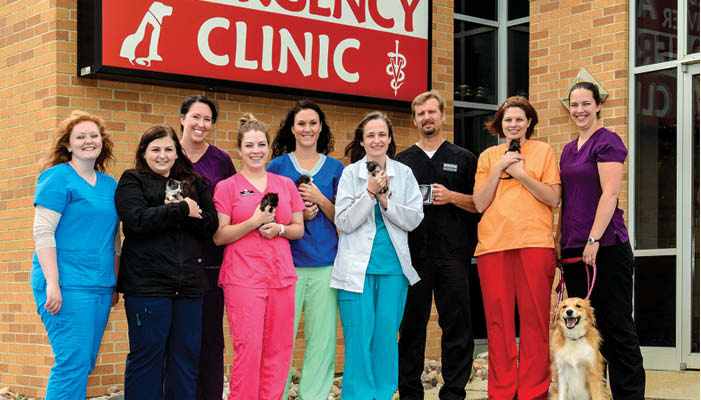Family emergencies don’t always respect office hours. When you’re worried about a two-legged loved one, you head to a hospital emergency room. But if it’s a furry, four-legged member of the family who’sbeen injured or fallen desperately ill, you can turn in another direction – Fargo-Moorhead’s emergency vets.
The Red River Animal Emergency Clinic has been caring for critically ill pets since 2005. While more familiar veterinary practices generally see their patients on regular weekday schedules, the emergency veterinarians and vet techs open their doors when their peers close up for the day … and stand by around the clock on weekends and holidays.
The clinic operates from 5 p.m. to 8 a.m. Monday through Thursday. When the lights go on at noon Friday, it will be open and fully staffed around the clock until the regular workweek begins.
“Animals have emergencies, too,” manager Bill Walker observes. “Dogs and cats are hit by cars. They ingest poisons and inhale smoke from house fires.” Too, they suffer from illnesses both chronic and acute, including the debilities of old age. The moment of crisis often comes at night, when their owners are home to observe it … but their regular veterinarians aren’t available on the spot.
Located just west of South University Drive at 1401 Oak Manor Ave. S., the emergency vet clinic cares for thousands of ailing patients and their people over the course of the year. “It’s not unusual for us to see nearly 100 patients over the weekend,” estimates Bill, who has managed the practice since 2010.
The clinic was launched 12 years ago by a group of local veterinarians. The manager explains the two reasons behind the innovative practice: “For one thing, sick and post-surgical dogs and cats need to be monitored closely. We can offer that continuity of care,” he explains It also relieves the increasing volume of after-hours calls from the daytime veterinarians’ regular patients, which – as the number of pets has grown – can overwhelm them when they’re on call. “That’s why we’re here. We offer the highest quality of care with extended hours, and they can trust we’re always open.”
The full-time staff includes five veterinarians, 10 licensed veterinary techs and a support staff of 10, many of them students of pre-veterinary medicine and veterinary technology at North Dakota State University. Several more vets and techs are available to fill in as needed. The clinic is open 132 hours per week – a schedule including overlapping coverage and 15-hour overnight shifts, with two spartan cots available for catching catnaps.
“These people have a true passion for taking care of animals. They inspire me,” he says. “I am in awe of the purity of their mission – giving every pet the absolute best chance they can.” When he joined the staff eight years ago, Bill intended only to help out for a few years; he’d just retired from 24 years operating the Pilot Flying J truck stop on Interstate 29 and had no experience in the field, other than a lifetime of loving his own pets.
But instead of a short-term way to occupy his suddenly free time, he was quickly infected with the enthusiasm all around him. “Now I have a mission, too. Mine is to make sure they have all the tools they need to do their jobs very, very well.”
The vet clinic, which was established and is owned by about a dozen veterinarians in the community, is as well-equipped as any human health-care facility … and with much of the same equipment. Its color Doppler ultrasound machine is the same kind that’s used by cardiac surgeons. Digital radiography provides x-ray insights, while endoscopic instruments offer an alternative to surgical removal of ingested surprises.
“The endoscope comes in handy. Dogs will eat anything,” Bill explains. They’ve found everything from a handful of rocks to chewed-up squeaky toys to, not too long ago, a wedding ring. Not all require the doctors’ intervention. “They confirmed the ring was in there,” he reports, “and then his owners just waited for it to come back out.”
The clinic operates a full laboratory for blood analysis and typing, urinalysis and other diagnostic testing, as well as an animal blood bank stocked with whole blood, packed red cells and fresh frozen plasma for treating rat poisoning. Two surgical suites, an isolation area, an incubator and veterinary intensive care units are shoehorned into the increasingly crowded facility, along with plenty of kennels. One of the surgeries is equipped with microsurgery instruments for the veterinary ophthalmologist who visits from Iowa two days per month.
While many of the vet clinic’s patients recover and walk out the door, an element of its practice focuses on end-of-life care – perhaps more frequently, he concedes, than the typical daytime clinic. The “comfort room” is a homelike area where families can spend final moments with a beloved pet.
Instead of a cold, clinical environment, the comfort room resembles the living room of a cozy cabin, with soft furniture, low lamplight and the flicker of a fireplace. The pet’s people are encouraged to take as much time as they need to reflect on good memories and say their final goodbyes.
Afterwards,as they emerge, they find the staff has lit a candle in memory of their beloved furry friend. “Our patients are very much a part of their families. It’s very difficult,” he says. “We all love pets of our own. We understand.”



